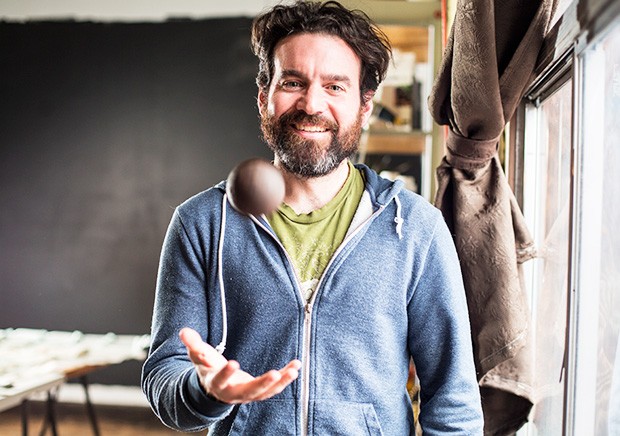‘If I die, I will meet you in the sun’
 “It’s about how objects are charged with the identities of history, laced with trauma, guilt and stress,” says Mitch Mitchell, an artist and assistant professor in the Department of Studio Arts. | © Concordia University, photo by Lisa Graves
“It’s about how objects are charged with the identities of history, laced with trauma, guilt and stress,” says Mitch Mitchell, an artist and assistant professor in the Department of Studio Arts. | © Concordia University, photo by Lisa Graves
Artist Mitch Mitchell has always shied away from incorporating personal narrative in his artwork — until now.
Mitchell, an assistant professor in Concordia’s Department of Studio Arts, uncharacteristically delves into family history in his first solo exhibition at the Art Gallery of Nova Scotia. The new work, Mitch Mitchell: I Will Meet You in the Sun, opens April 16 and runs until June 5.
“The title of the exhibition is a passage from a letter that my 19-year-old grandfather wrote to his future wife, my grandmother, while he was part of a military offensive in Guam during World War II,” says Mitchell, who teaches intaglio printing courses in Print Media.
“He wrote a passage saying, ‘If I die, I will meet you in the sun’,” he says. “The exhibition is about the psychology and after-effects of the war, and its remnants through history and time. It’s about how objects are charged with the identities of history, laced with trauma, guilt and stress — of what the Scotch-Irish refer to as ‘working out the devil.’”

Post-war process pieces
The exhibition will feature approximately 10 new sculptural installations, including film/video pieces. One piece, Berth, has been a work-in-progress since 2014. The installation is comprised of 35,000 individually silkscreened, folded, cut and glued paper boxes. Some people liken them to bricks or small cargo containers.
“At my grandfather and grandmother's house, there was a palette stacked with old bricks in their backyard,” he recalls.
“As a child, I was infatuated with it. With this piece, it's about the multiplicity of production,” says Mitchell, originally from Illinois. “It's really beautiful, with the colours, but then you realize that an individual handmade every one. So there's a brand new psychology introduced — the idea of stress and trauma. Why would a person sit and make these over and over, and indulge this psychosis?” he asks.
There's the tension between the beautiful and the tedious, the all consuming as well as the consumed, production en masse versus unique production. They're all territories open for examination.”
As another nod to his grandparents, Mitchell remade a U.S. wheat head penny from 1943, the year his grandfather was in the war. The piece, called True Story, was difficult to make because he had to learn how to — lawfully — counterfeit a coin.
“At that time, U.S. pennies were made of steel instead of copper, because copper was needed for bullets and shells,” says Mitchell. “By remaking the coin in copper, I'm proposing the idea of what would have happened if the war didn't happen? What if my grandfather didn't have to go to war at a young age? What if all the soldiers didn't have to die? And the Holocaust didn't happen? Or Hiroshima?”
Working-class hero
The Art Gallery of Nova Scotia’s chief curator, Sarah Fillmore, has praised Mitchell’s art for paying homage to hard work and giving voice to the unsung workers of our industrial past and present. She also notes his mastery of age-old printing methods — including etching, photogravure, intaglio and silkscreen — and how he implicates print into sculpture, performance and film.
She’s pleased to mount this exhibition of new work, with its personal twist.
“The pieces speak about many things, including Mitch’s grandfather’s time as a radar technician — as the first to witness, through the blip on his radar screen, the explosions of Hiroshima, not knowing until later the horrors he had unwittingly participated in,” she says.
“He spent his post-service life in the coal mines, doing physical labour that would help exorcise [his wartime] demons,” says Fillmore. “Mitch is understandably a product of his grandfather's mindset and work ethic. He has a dedicated and driven approach to art making, and printmaking is a natural fit. However, he often takes on the role of the machine, not content to have an automated version of what can be produced by hand.”
 Image courtesy of Mitch Mitchell.
Image courtesy of Mitch Mitchell.
'Dynamic and invested'
Concordia’s Department of Studio Arts appreciates Mitchell’s hands-on approach.
“Mitch is one of those faculty members who is incredibly dynamic and invested,” says Rebecca Duclos, dean of the Faculty of Fine Arts.
“He is continually advocating for his students and bringing opportunities to them, and to the larger fine arts community,” she says. “Whether he is organizing donations of materials, bringing in exceptional artists, supporting our efforts to explore art and science connections, running mural contests for the new foyer space, forging connections with industry and institutional partners or connecting us with colleagues across Canada and internationally, Mitch excels at everything he puts his hand in. Oh, and did I say that he has done all of the above in just the short six months since I’ve known him?”
Mitchell has exhibited nationally and internationally in numerous solo and group exhibitions and was selected to represent Canada in the Printmaking Biennial in Douru, Portugal (2010 and 2012), and the Contemporary Print in Canada exhibition at the Chonqing National Gallery in China.
He has won multiple national and international awards for his work, which can be found in museums and private collections including the Boston Museum of Fine Arts, Art Gallery of Nova Scotia, Serralves Contemporary Museum of Art in Portugal and the Art Gallery of Alberta.
Catch Mitch Mitchell: I Will Meet You in the Sun from April 16 to June 5, 2016, at the Art Gallery of Nova Scotia in Halifax.


